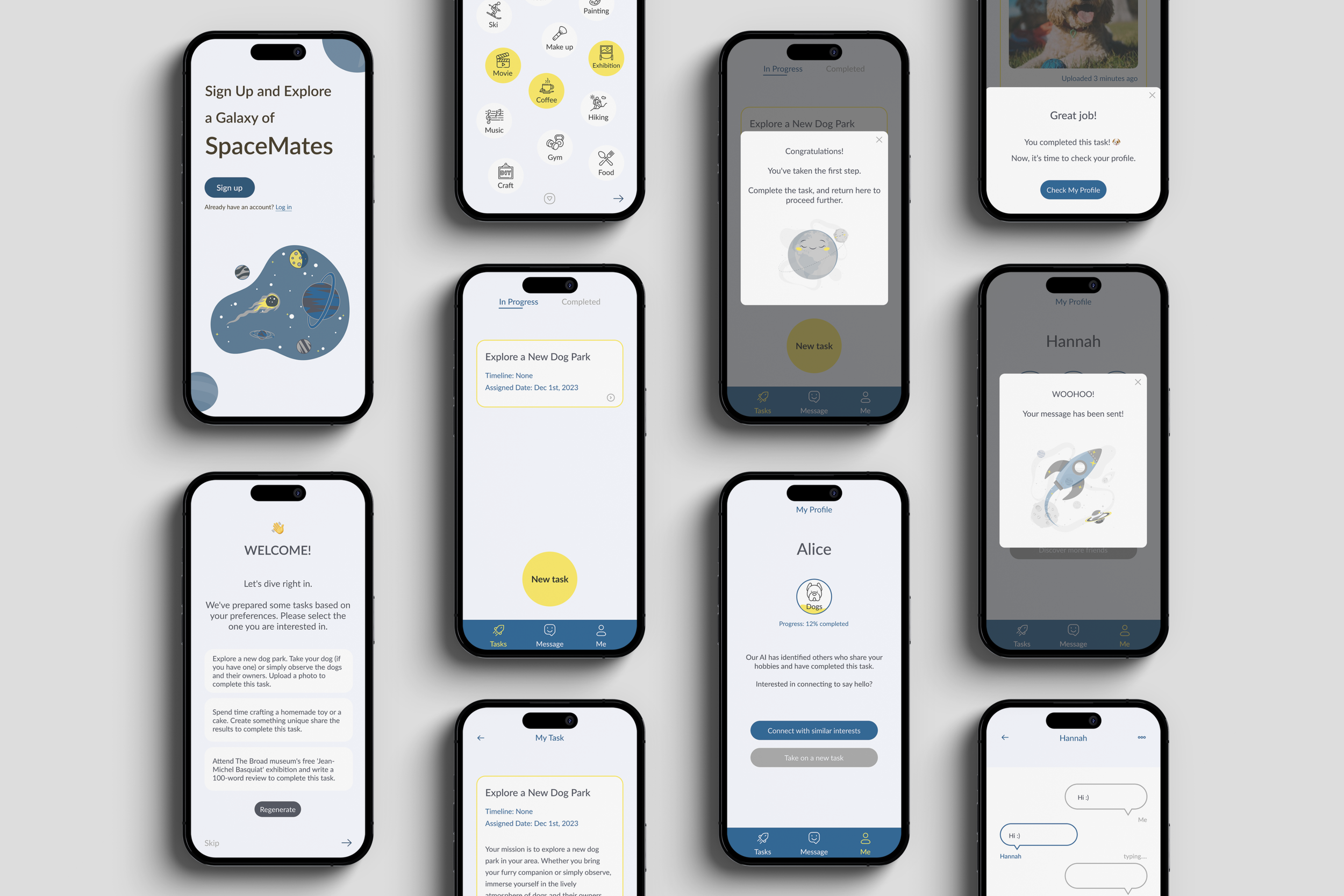SpaceMates
AI + UX DESIGN CHALLENGE
SpaceMates is an app dedicated to connecting individuals seeking like-minded friends through AI-generated tasks, fostering genuine friendships based on shared interests and pacing rather than focusing on dating.
Recognized as an Honorable Mention in the AI + UX Design Challenge 2023, a competition co-hosted by STRATMINDS and Design Bubbies. SpaceMates reflects my collaborative efforts with fellow product designer Hailey and showcases our commitment to redefining social connections through thoughtful UX design. As individuals studying and working in a foreign country, forging friendships presented added challenges for both Hailey and me. This personal struggle inspired our mission to develop this app. Our goal is to harness AI's capabilities to facilitate connections and match individuals with like-minded friends.
Context.
Time: December 1st - 10th (10 Days)
Role: UX Designer
Team: Me and Hailey

Is making friends as an adult challenging?
The resounding answer is 'Yes'.
How do you make new friends?
Why do you want to meet new people or make friends?/ In what situations do you need to make new friends?
What do you care most about when you are building a relationship?
What challenges do you typically face when trying to make new friends?
Have you ever use social apps?
Can you share a positive experience where a social app?/Or any barriers or concerns?
In your opinion, what role does pacing play in fostering genuine friendships through social apps?
Studies indicate a concerning trend where a significant portion of adults admit to having few or no close friends. This difficulty in forging adult friendships stems from various factors, including time constraints, challenges in building trust, and the impact of age on social connections.
To substantiate the findings from our research and gain deeper insights into individuals' perspectives on social apps, we conducted interviews with a diverse group of six participants, all aged 20 and above. This interview cohort was evenly divided between male and female participants, ensuring a well-rounded understanding of experiences and viewpoints.
From the interviews, we gained pivotal insights:
Limited ways to make new friends
Challenges in forging friendships
Lack of trust in social apps
Social apps lean heavily toward romantic connections
We proceeded with a competitive analysis, evaluating four popular social apps based on their strengths, weaknesses, opportunities, and threats (SWOT).
Competitor Analysis
Persona&Journey Mapping

Design Proposal
Throughout the ideation phase, we agreed to employ AI-generated tasks for user engagement. This approach not only facilitates more precise friend matching based on shared interests but also acts as a catalyst for initiating conversations, breaking the ice between users.
Sketches
At this stage, Hailey and I encountered differing perspectives on task implementation within the app. Hailey leans towards an approach where the AI initially matches friends based on user-provided basic information. Following the connection, tasks are completed together, gradually revealing more information—such as avatars—as more tasks are completed.
On the other hand, my perspective advocates for an alternative approach. I propose the AI generates diverse tasks based on user information. Upon task completion, the AI matches users who have completed the same task, allowing users to decide whether or not to establish contact.
After creating user flows for both proposals, we concluded. The approach involving users working together to complete tasks before deepening conversations increases the time investment without ensuring the AI always matches the most suitable friend for the user. As we prioritize user autonomy in making choices, the final design direction will align with my concept.
HIGHLIGHTED FEATURES
Simple onboarding
Six easy steps help the AI understand users by gathering information about their city, interests, and preferred time, enhancing task recommendations. Users can also input personalized content. Omitting the usual avatar upload devoid of physical appearance influence.
AI task generation
The AI generates various user-friendly tasks for selection, generally offering easily achievable options. Tasks are designed not only to provide activities for users but also to enrich their lives and align with their areas of interest. This approach aims to offer enjoyable experiences that resonate with users' preferences and bring value to their daily lives within the app.
Friend Match
Once a task is completed, the interest bubbles are updated. The AI then suggests friends based on completed tasks and shared interests. Increased task completions improve match accuracy, aiding users in assessing potential friends. These completed tasks can also initiate conversations between users upon connection. Users maintain control over connections, deciding when to connect.

Learnings & Reflections
Although this project spanned 10 days, it encompassed various crucial stages, including user research, interviews, competitive analysis, user journey mapping, and comprehensive design from inception to execution. Due to time constraints, our primary focus was designing key pages within the happy path process. Looking ahead, I aspire to enhance the project by incorporating collaborative task completion features, inviting other users to join and engage together in tasks. This collaborative aspect would add depth and interaction to the user experience.
The limited time stimulated our creativity and tested our design skills. It's good to encounter disagreements in design, it shows that we are all trying to think hard. Designers should bump into each other and learn from each other in such a process, which is a very important point I realized in this project.





